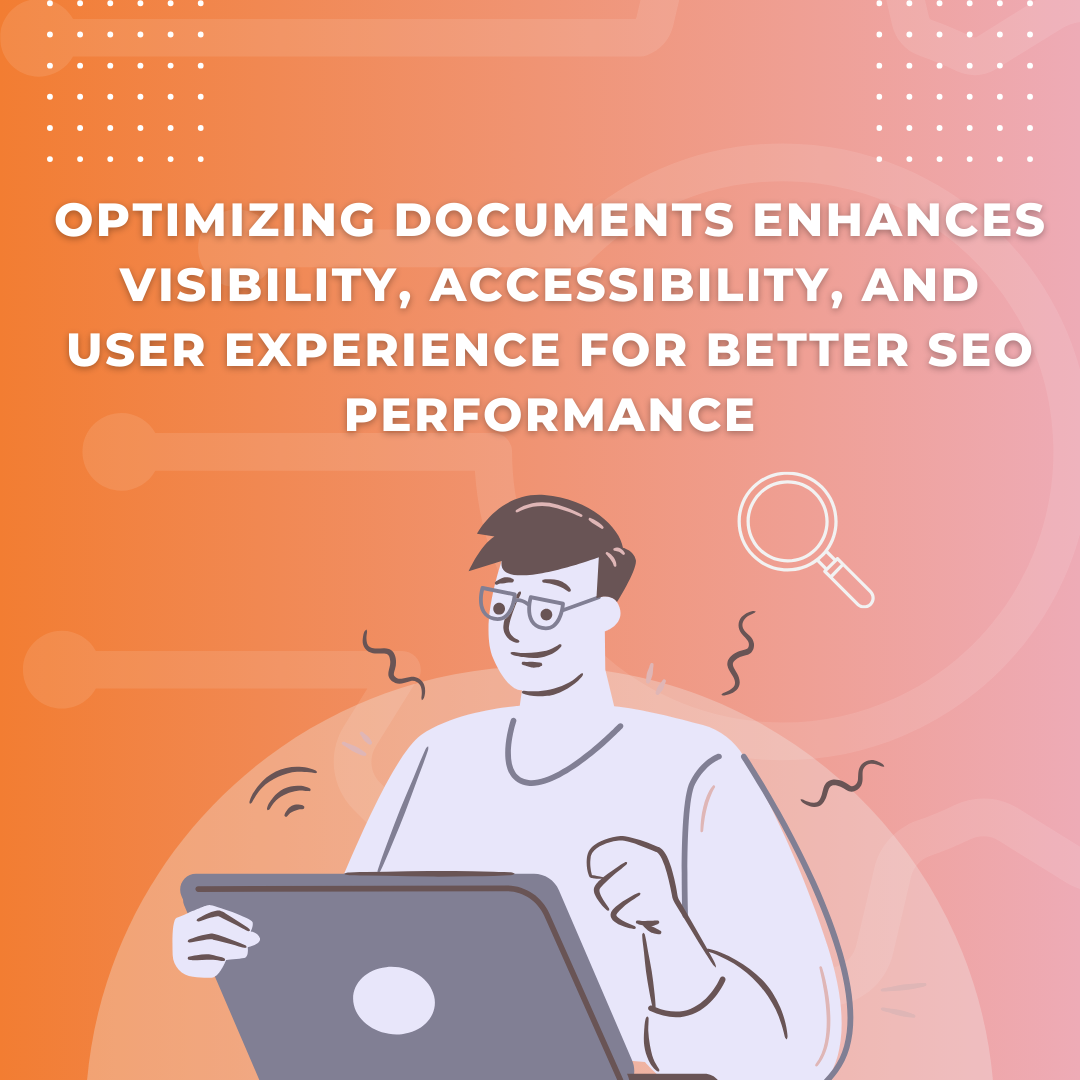The importance of documents conversion
Document conversion SEO refers to the process of optimizing different types of documents, like PDFs, Word files, and presentations. The benefits of document conversion SEO include:
• More people finding your content.
When you optimize your documents, search engines are more likely to show them to people searching for related information.
• Improved accessibility.
Optimizing your documents makes them more accessible to people with disabilities. This includes features like proper tagging and alternative text, which help people using assistive technologies to understand the content.
• Potential for more links and shares.
When your documents are optimized, other websites may link to them or share them on social media. This increases your website's authority, which is important for SEO.
Impact on Accessibility and User Experience
Document conversion SEO makes your content more accessible and easy to use. Here's why:
• Easier to Read.
Using headings, bullet points, and other visual cues breaks up the content and makes it simpler to understand.
• Simple Navigation.
This includes things like a table of contents or bookmarks that let people jump to specific sections. When navigation is simple, people can find what they're looking for faster and have a smoother experience.
• Faster Loading.
Optimized documents load faster, which is important for a good user experience. Slow-loading documents can be frustrating and cause people to leave the page. Documents with faster loading are ranked higher by Google.
Overall, document conversion SEO makes documents more accessible and easier to use for everyone. It improves readability, simplifies navigation, works well on mobile devices, loads faster, and is compatible with different devices and browsers.
Using Structured Content for SEO Benefits
Here are the benefits of structured content for SEO:
• Easy for search engines to understand.
Structured content helps search engines understand the hierarchy of your web pages. This makes it easier for search engines to index your content.
• Better keyword optimization.
By using headings and subheadings to highlight important keywords, you can show search engines the relevance of your content. It will improve your rankings for those keywords.
• Featured snippets.
Search engines often use structured content to create featured snippets, which are highlighted answers displayed at the top of search results. By structuring your content well, you increase the chances of your content being featured, attracting more clicks.
• Internal linking.
Structured content makes it easier to create effective internal links within your website. By using clear anchor text in headings and subheadings, you connect different pages and sections of your website. This helps users navigate and search engines understand the relationships between your content.
Leveraging Content Platform SEO
Optimize metadata, headings, and URLs for document-based web pages. Here's how to work with each element:
1. Metadata Optimization.
• Meta Title. Create a short, descriptive title that includes relevant keywords and accurately represents the document's content.
• Meta Description. Write a brief summary of the document using keywords naturally. Make it appealing to users and encourage them to click on the link.
Optimizing metadata helps search engines understand the document's content and display useful information in search results.
2. Heading Optimization.
• H1 Heading. Use a clear heading that represents the main topic of the document and includes relevant keywords.
• Subheadings. Divide the document into sections using subheadings (H2, H3, etc.) and include keywords when appropriate.
• Heading Hierarchy. Maintain a logical structure for headings to make it easy for search engines and users to navigate the content.
3. URL Optimization.
• Readable Structure. Create URLs that are easy to read and understand, giving an idea of the page's content.
• Keywords. Include relevant keywords in the URL to indicate the page's topic and improve search engine visibility.
• Hyphens. Use hyphens to separate words in the URL for better readability.
Optimizing URLs makes them user-friendly and helps search engines interpret the page's content.

Incorporating Relevant Keywords and Phrases
Here's how you can do it:
1. Keyword Research.
Find words and phrases that are relevant to your website and what people search for. Use tools like Google Keyword Planner to help you discover these keywords.
2. On-Page Optimization.
• Page Titles. Use keywords in your page titles to describe what the page is about.
• Headings and Subheadings. Include keywords in headings and subheadings to show the main topics of your content.
• Content Body. Naturally use keywords throughout your content, but don't overdo it. Make sure the keywords fit well within the sentences and make sense.
3. Image Optimization.
• File Names. Provide your images with descriptive names that have relevant keywords.
• Alt Text. Add alt text to your images with a description that includes keywords. This assists search engines in understanding the content depicted in the image.
4. URLs and Permalinks.
• Include keywords in your web page's URL to give search engines a clear idea of what the page is about.
5. Internal and External Linking.
• Internal Links. Use keywords as anchor text when linking to other pages on your website. This aids search engines in comprehending the connection between your web pages.
• External Links. When linking to other websites, use keywords in the anchor text to provide more information to search engines.
Remember to use keywords naturally and avoid using them too frequently, which can hurt your SEO. Focus on creating helpful and valuable content for your audience.
Internal and External Linking Strategies
Using internal and external links helps improve your website's performance. Here's how:
1. Internal Linking.
Internal linking is creating links to other pages inside your own website. Here are some tips:
• Use clear words for your links that describe where they go.
• Link related content together to provide more information to users.
• Include links in your website's menus or sidebars to help users find important pages.
• Make sure the number of links on a page is reasonable and relevant.
External Linking.
When you include links to other websites from your own, it is called external linking. It has benefits for both search engines and users. Here's why it's useful:
• It shows that you've done your research and can be trusted.
• Search engines see external links as a sign that your website is relevant and reliable.
• When you link to other websites, it can help you establish relationships with other website owners.
• It gives users more information and a better experience.
When using external links, make sure they are from trustworthy sources and related to your content.
By using both internal and external links effectively, you improve your website's credibility. It also provides users with a better experience by helping them find relevant information.

Optimizing Images and Multimedia Elements
Here's how you can optimize them effectively:
1. Image Compression.
• Compress your images to reduce file size without compromising quality. Smaller file sizes help improve website loading speed, which is crucial for user experience and SEO.
• Use image compression tools or plugins to automatically optimize images during the upload process.
2. Image Format Selection.
• Choose the appropriate image format for different types of images. Common formats include JPEG for photographs and PNG for images with transparency or text-based elements.
• Use WebP or other modern image formats where supported, as they can provide better compression without sacrificing quality.
3. Multimedia Optimization.
• Compress video and audio files to reduce their file sizes without compromising quality. This helps improve loading times and user experience.
• Provide transcripts or closed captions for videos to make them accessible to all users, including those with hearing impairments. Search engines can also index the text, improving SEO.
• Use schema markup for multimedia elements to provide additional information to search engines.
4. Lazy Loading.
• Implement lazy loading for images and multimedia elements. This technique allows images to load as users scroll down the page, reducing initial page load time.
5. Sitemap Inclusion.
• Include image and multimedia sitemaps in your website's XML sitemap. This helps search engines discover and index your media files.
Optimizing images and multimedia elements, you improve website performance, enhance user experience, and boost search engine visibility. This leads to faster loading times, better accessibility, and higher chances of your content being discovered by users.
Key Points of the Article
1. Transforming PDF/documents into a website unlocks SEO potential. Optimizing documents improves visibility, drives organic traffic, and reaches the target audience effectively.
2. Document conversion SEO makes documents more accessible for people with disabilities, easier to read, simplifies navigation, works well on mobile devices, loads faster, and is compatible with different devices and browsers.
3. Structured content helps search engines understand the organization of web pages, improves keyword optimization, increases visibility through featured snippets, and facilitates internal linking.
4. Optimizing metadata, headings, and URLs for document-based web pages improves search engine visibility and SEO performance. Metadata optimization involves creating descriptive titles and summaries. Heading optimization includes using clear headings, and subheadings, and maintaining a logical structure. URL optimization focuses on creating readable URLs with relevant keywords.
5. Keyword research helps discover relevant keywords for on-page optimization, including page titles, headings, subheadings, content body, image optimization, URLs, and permalinks. Using keywords naturally and creating valuable content is crucial.
6. Internal linking improves website structure and user navigation, while external linking enhances credibility, trustworthiness, and user experience. Both internal and external links contribute to better organization and visibility in search engines.
7. Image optimization involves compressing images, choosing appropriate formats, adding alt text, and ensuring responsive design. Multimedia optimization includes video and audio compression, providing transcripts and closed captions, implementing schema markup, and utilizing lazy loading.
Sources for the article: Moz, Search Engine Journal, Yoast, HubSpot, Neil Patel.
The fastest way to build digital experiences. We empower businesses to convert PDFs, presentations and other content into interactive experiences & webpages with instant branding, analytics & more



